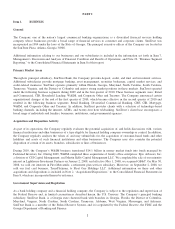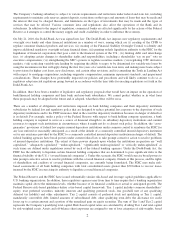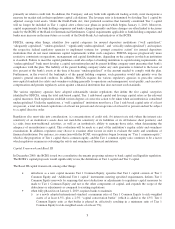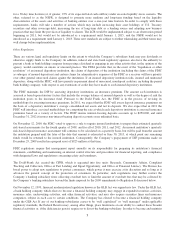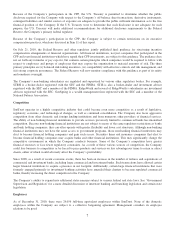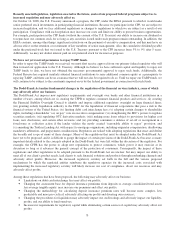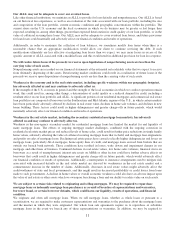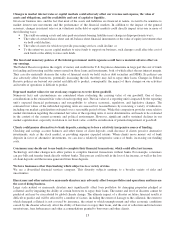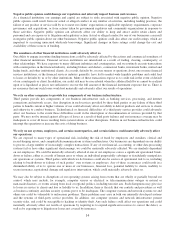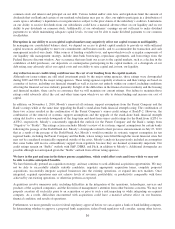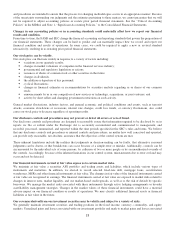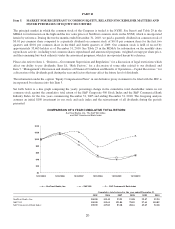SunTrust 2010 Annual Report Download - page 27
Download and view the complete annual report
Please find page 27 of the 2010 SunTrust annual report below. You can navigate through the pages in the report by either clicking on the pages listed below, or by using the keyword search tool below to find specific information within the annual report.Our ALLL may not be adequate to cover our eventual losses.
Like other financial institutions, we maintain an ALLL to provide for loan defaults and nonperformance. Our ALLL is based
on our historical loss experience, as well as an evaluation of the risks associated with our loan portfolio, including the size
and composition of the loan portfolio, current economic conditions and geographic concentrations within the portfolio. The
current stress on the U.S. economy and the local economies in which we do business may be greater or last longer than
expected, resulting in, among other things, greater than expected deterioration in credit quality of our loan portfolio, or in the
value of collateral securing these loans. Our ALLL may not be adequate to cover eventual loan losses, and future provisions
for loan losses could materially and adversely affect our financial condition and results of operations.
Additionally, in order to maximize the collection of loan balances, we sometimes modify loan terms when there is a
reasonable chance that an appropriate modification would allow our client to continue servicing the debt. If such
modifications ultimately are less effective at mitigating loan losses than we expect, we may incur losses in excess of the
specific amount of ALLL associated with a modified loan, and this would result in additional provision for loan loss expense.
We will realize future losses if the proceeds we receive upon liquidation of nonperforming assets are less than the
carrying value of such assets.
Nonperforming assets are recorded on our financial statements at the estimated net realizable value that we expect to receive
from ultimately dispensing of the assets. Deteriorating market conditions could result in a realization of future losses if the
proceeds we receive upon dispositions of nonperforming assets are less than the carrying value of such assets.
Weakness in the economy and in the real estate market, including specific weakness within our geographic footprint,
has adversely affected us and may continue to adversely affect us.
If the strength of the U.S. economy in general and the strength of the local economies in which we conduct operations remain
weak, this could result in, among other things, a deterioration of credit quality or a reduced demand for credit, including a
resultant effect on our loan portfolio and ALLL. A significant portion of our residential mortgages and commercial real estate
loan portfolios are composed of borrowers in the Southeastern and Mid-Atlantic regions of the U.S., in which certain markets
have been particularly adversely affected by declines in real estate value, declines in home sale volumes, and declines in new
home building. These factors could result in higher delinquencies and greater charge-offs in future periods, which would
materially adversely affect our financial condition and results of operations.
Weakness in the real estate market, including the secondary residential mortgage loan markets, has adversely
affected us and may continue to adversely affect us.
Weakness in the non-agency secondary market for residential mortgage loans has limited the market for and liquidity of
many mortgage loans. The effects of ongoing mortgage market challenges, combined with the ongoing correction in
residential real estate market prices and reduced levels of home sales, could result in further price reductions in single family
home values, adversely affecting the value of collateral securing mortgage loans that we hold, and mortgage loan originations
and profits on sales of mortgage loans. Declining real estate prices have caused cyclically higher delinquencies and losses on
mortgage loans, particularly Alt-A mortgages, home equity lines of credit, and mortgage loans sourced from brokers that are
outside our branch bank network. These conditions have resulted in losses, write downs and impairment charges in our
mortgage and other lines of business. Continued declines in real estate values, low home sales volumes, financial stress on
borrowers as a result of unemployment, interest rate resets on ARMs or other factors could have further adverse effects on
borrowers that could result in higher delinquencies and greater charge-offs in future periods, which would adversely affect
our financial condition or results of operations. Additionally, counterparties to insurance arrangements used to mitigate risk
associated with increased defaults in the real estate market are stressed by weaknesses in the real estate market and a
commensurate increase in the number of claims. Additionally, decreases in real estate values might adversely affect the
creditworthiness of state and local governments, and this might result in decreased profitability or credit losses from loans
made to such governments. A decline in home values or overall economic weakness could also have an adverse impact upon
the value of real estate or other assets which we own upon foreclosing a loan and our ability to realize value on such assets.
We are subject to certain risks related to originating and selling mortgages. We may be required to repurchase
mortgage loans or indemnify mortgage loan purchasers as a result of breaches of representations and warranties,
borrower fraud, or certain borrower defaults, which could harm our liquidity, results of operations, and financial
condition.
We originate and often sell mortgage loans. When we sell mortgage loans, whether as whole loans or pursuant to a
securitization, we are required to make customary representations and warranties to the purchaser about the mortgage loans
and the manner in which they were originated. Our whole loan sale agreements require us to repurchase or substitute
mortgage loans in the event we breach any of these representations or warranties. In addition, we may be required to
11


